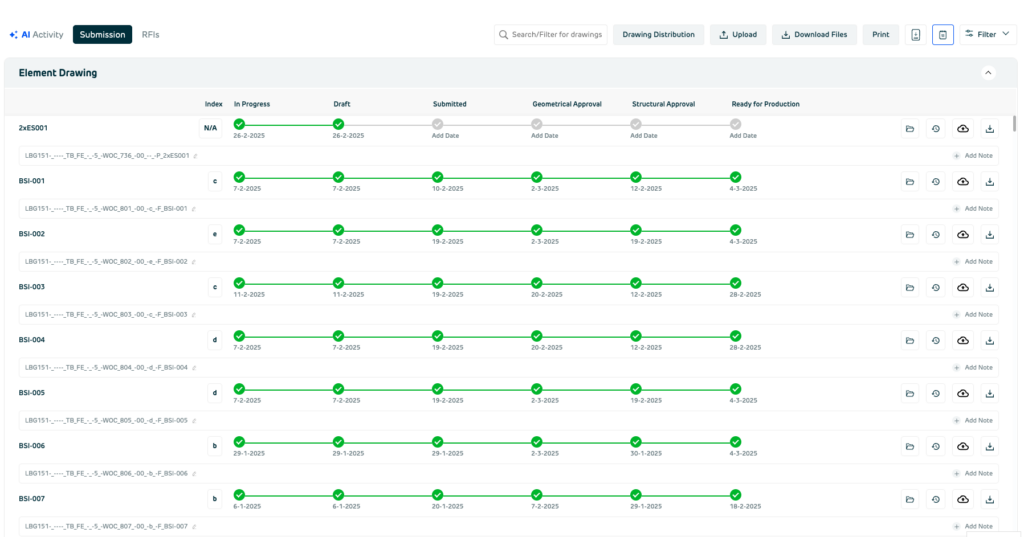On a bustling construction project, a project manager at a major civil engineering project received a pile of submittals that had been “rejected” repeatedly.
Every rejected submittal, whether a single submittal or a complete submittal package, delayed the construction submittal process, increased project delays, and disrupted the project schedule.
The manual process of preparing submittals was time consuming and error prone, causing the review process to stall. By completely overhauling the submittal workflow and integrating an easy to use platform for document management, construction manager and the responsible contractor transformed the submittal process.
Now, every construction submittal is managed through a clear submittal tracking system that ensures the review and approval process is streamlined. This transformation—from rejected to submittals approved—is the result of applying the right strategies, tools, and discipline to meet project specifications and contract documents while upholding quality assurance and design intent.
Defining Submittals in Construction
Submittals are the documented assurances that every element of a construction project meets design intent and contractual requirements. They function as the communication link between the contractor, design team, and the project owner, ensuring that the planned work is executed correctly.
Key points include:
- Quality Assurance: Submittals verify that the materials, methods, and products used match the specifications.
- Compliance: They ensure that every element is in line with regulatory standards and contract documents.
- Project Alignment: By documenting details, submittals help maintain consistency throughout the project lifecycle.
The Hyatt Regency Walkway Collapse tragically underscored how a failed submittal review—in this case, an alternate design for suspension rods—can result in catastrophic outcomes. This example remains a stark reminder of the importance of meticulous submittal processes in construction industry.
Experience the simplicity of BuildTwin’s Drawing Register—upload your Excel file with a drag-and-drop and instantly organize your drawings.
Explore the Platform >>
What Is a Drawing Submittal?
A drawing submittal is a specific type of submittal that includes detailed plans construction specifications, and schematics—often called “shop drawings”—that illustrate how a contractor intends to execute a portion of the work. However, submittals extend well beyond drawings. Common types include:
Shop Drawings:
- Details: Shop drawings offer exact dimensions, fabrication details, and installation instructions. A shop drawing is vital for ensuring that the construction submittal process is accurate.
- Example: A steel fabricator’s shop drawing for structural connections must be reviewed by the design team.
Material Data & Product Data:
- Details: These submittals include cut sheets, technical data, and product data submittals that confirm the quality of different materials.
- Example: Product data showing that an HVAC unit meets the required performance standards is essential for the construction contract.
Samples:
- Details: Material samples, or product samples, are physical examples used to verify that the construction submittals include the correct materials.
- Example: Tiles, paint chips, or concrete cylinders are reviewed to ensure they match the design documents.
Test Reports and Calculations:
- Details: Engineering calculations (e.g., load, stress, or fluid dynamics) and lab test reports provide technical data for quality assurance.
Mix Designs & Erection Drawings:
- Details: Specific submittal documents for materials like concrete and instructions for assembling structural elements are key.
Operation & Maintenance (O&M) Manuals and Warranties:
- Details: These submittals are provided at project closeout, ensuring that maintenance manuals are available for future operations.
Submittal Categories: More Than Just Three Types
A recurring question in the industry is: “Are there only three types of submittals?” In practice, submittals can be grouped by their function into three broad categories, but the reality is more nuanced:
Informational Submittals:
- For record keeping only—e.g., daily progress reports.
- No approval is necessary; these documents serve as internal logs.
Action Submittals:
- Require review and formal approval before work can proceed (e.g., shop drawings, product data).
- They act as a green light for fabrication or installation.
Closeout Submittals:
- Submitted at the end of the project, including warranties, as‑built drawings, and O&M manuals.
- These documents ensure proper handover and future maintenance.
In any construction project, the project plans have types of submittals and the submittal process may include multiple submittal documents. Project teams must focus on preparing submittals accurately and tracking submittals to prevent project delays.
The Importance of the Submittal Log
A robust submittal log is your command center for managing, tracking, and ensuring accountability throughout the review final approval process. It’s not just a spreadsheet—it’s the life-blood of the documentation process.
Key Components & Tracking Tips
Below is a table summarizing essential elements:
| Element | Why It’s Important |
|---|---|
| Submittal Number | Unique ID for tracking and reference. |
| Description & Spec Reference | Clearly defines what is being submitted and links to contract details. |
| Required & Actual Submission Dates | Tracks adherence to schedules and identifies delays. |
| Review Status & Comments | Provides visibility into the review cycle (e.g., Under Review, Approved). |
| Reviewer/Action By & Dates | Assigns accountability for timely and quality responses. |
| Return Date & Remarks | Documents when and why changes were needed to prevent future errors. |
Tracking Tips:
- Use a digital log (spreadsheet, database, or specialized softwares like BuildTwin).
- Assign responsibility to a dedicated team member.
- Set automated reminders and update the log regularly.
- Hold regular review meetings to discuss bottlenecks.
See how BuildTwin’s AI Activity Stream and RFI Tracker can streamline your submittal process for maximum efficiency. See it in action
The Submittal Checklist: Ensuring Completeness and Accuracy
A well-designed submittal checklist is the ultimate quality-control tool. It minimizes errors, reduces the project manual rework, and prevents delays. The checklist should include:
Key Checklist Items Include:
- All required documents (drawings, samples, test reports, etc.) are attached.
- Documents are formatted correctly and in the proper version.
- Specification references are correctly cited.
- The correct number of copies is included.
- Submission and review dates are clearly noted.

Understanding Submittal Documents and Their Scope
The term “submittal document” refers to any piece of documentation included in a submittal package. These documents span a broad spectrum:
- Technical Drawings: Detailed shop drawings and design schematics.
- Product Data: Specifications, cut sheets, and manufacturer certificates.
- Samples and Mockups: Physical examples and prototypes of materials.
- Test Reports and Calculations: Verifications from labs or engineering analyses.
- O&M Manuals & Warranties: Documents provided at project closeout for future maintenance.
Understanding this variety is crucial. Each document type plays a specific role in the project success, verifying that all project elements meet the design intent and contractual requirements, ultimately ensuring a successful build.
Deferred Submittals vs. Delegated Design
Sometimes, a project requires that certain submittals be intentionally delayed—these are known as deferred submittals.
What Is a Deferred Submittal?
A deferred submittal is one that is scheduled for submission later in the project lifecycle, often because the item is not needed immediately. For instance:
- Example: A curtain wall system may be deferred until after initial structural work is complete, ensuring design development is finalized and any potential changes can be accommodated.
Why Use Deferred Submittals?
- Schedule Flexibility: Deferred submittals allow the contractor to focus on critical early-phase work without being overwhelmed by every detail at once.
- Design Finalization: Some items may require more time for design refinement before they can be accurately documented.
Deferred Submittals vs. Delegated Design
It is essential not to confuse deferred submittals with delegated design:
- Deferred Submittal: The timing of the submission is delayed; however, the design responsibility remains with the original design team.
- Delegated Design: Design responsibility is specifically handed over to the contractor or a specialty subcontractor, often leading to submittals that are deferred while that team develops the design.
Understanding this distinction is critical for ensuring proper accountability and preventing miscommunication among project participants and stakeholders.
Leveraging Submittal Software for Efficiency
In today’s digital age, construction submittals are increasingly managed using specialized software. Benefits of using submittal and construction management software include:
- Centralized Tracking: All submittals are stored in one location, accessible by all stakeholders.
- Automated Workflows: Automated reminders, notifications, and status updates streamline the review process.
- Improved Collaboration: Multiple team members can review, comment, and revise submittals in real time.
- Enhanced Reporting: Generate analytics and reports to track performance, response times, and bottlenecks.

Platforms like BuildTwin have revolutionized submittal management by cutting review times significantly, which is critical for maintaining project schedules.
Conclusion
In civil engineering projects, a robust submittal management process is crucial for quality assurance, meeting contract requirements, and ensuring the construction project’s overall success. By streamlining the submittal workflow, utilizing a comprehensive submittal log template, following a detailed submittal checklist, and leveraging modern submittal software, your project teams—from the general contractor to the design team—can ensure that every submittal, whether it is a shop drawing, construction schedule, product data submittal, or material sample, transitions from “rejected” to “approved” seamlessly.
Ready to transform your project requirements submittal workflow? Discover BuildTwin’s comprehensive suite for drawing registers, AI activity streams, and RFI management—streamline your process and boost project efficiency today. Explore BuildTwin Now>>



